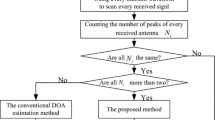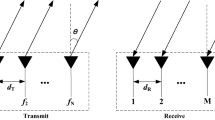Abstract
The sparse Multiple-Input–Multiple-Output radar has large array element spacing, which has a great significance for reducing the mutual coupling effects. In this paper, the authors propose a compensation sparse arrays with flexible inter-element spacing (CSA-FIS). Compared with the sparse arrays with flexible inter-element spacing (SA-FIS), the CSA-FIS improves the situation in that the number of virtual sensors significantly decreases when the inter-element spacing of two sub-array is not coprime. Under the guarantee of lower mutual coupling effects, the system degrees of freedom (DOFs) and the number of consecutive virtual sensors are also improved. Meanwhile, a pre-processing DFT-compressed sensing (D-CS) algorithm is proposed, with the purpose to solve the problem that the traditional CS algorithm has a high calculation cost when all non-zero parameters must be estimated. Numerical simulations demonstrate the superiority of the CSA-FIS in terms of DOFs and estimation accuracy when compared with SA-FIS. Moreover, compared with the traditional CS algorithm, the D-CS has lower computational complexity.











Similar content being viewed by others
Data Availability Statement
The position of the virtual sensor in this paper is the data generated by the simulation. Array location data to support the results of this study can be obtained from the corresponding authors upon request.
References
Fishler E., Haimovich, A., & Blum, R. et al. (2004). MIMO radar: an idea whose time has come. In Proceedings of the 2004 IEEE Radar Conference (IEEE Cat. No.04CH37509), Philadelphia, pp. 71–78. https://doi.org/10.1109/NRC.2004.1316398.
Li J., & Stoica, P. (2009). MIMO Radar diversity means superiority. MIMO Radar Signal Processing, IEEE, pp.1–64. https://doi.org/10.1002/9780470391488.ch1.
Goudos, S. K., Miaris, G. S., Siakavara, K., et al. (2007). On the orthogonal nonuniform synthesis From a set of uniform linear arrays. IEEE Antennas and Wireless Propagation Letters, 6, 313–315. https://doi.org/10.1109/LAWP.2007.899915
Wang, Z., Xie, W., Zou, Y., & Wan, Q. (2019). DOA Estimation using single or dual reception channels based on cyclostationarity. IEEE Access, 7, 54787–54795. https://doi.org/10.1109/ACCESS.2019.2912907
Zou, Y., & Liu, H. (2020). TDOA Localization with unknown signal propagation speed and sensor position errors. IEEE Communications Letters, 24(5), 1024–1027. https://doi.org/10.1109/LCOMM.2020.2968434
Xie, W., Wen, F., Liu, J., & Wan, Q. (2017). Source association, DOA, and fading coefficients estimation for multipath signals. IEEE Transactions on Signal Processing, 65(11), 2773–2786. https://doi.org/10.1109/TSP.2017.2669894
Schmidt, R. O. (1986). Multiple emitter location and signal parameter estimation. IEEE Transactions on Antennas and Propagation, 34(3), 276–280. https://doi.org/10.1109/TAP.1986.1143830
Chakrabarty, S., & Habets, E. A. P. (2019). Multi-Speaker DOA estimation using deep convolutional networks trained with noise signals. IEEE Journal of Selected Topics in Signal Processing, 13(1), 8–21. https://doi.org/10.1109/JSTSP.2019.2901664
Malioutov D., Cetin, M., & Willsky, A. S. (2005). A sparse signal reconstruction perspective for source localization with sensor arrays. IEEE Transactions on Signal Processing, 53 (8), 3010–3022. https://doi.org/10.1109/TSP.2005.850882.
Shi, Z., Zhou, C., Gu, Y., Goodman, N. A., et al. (2017). Source estimation using coprime array: A sparse reconstruction perspective. IEEE Sensors Journal, 17(3), 755–765. https://doi.org/10.1109/JSEN.2016.2637059
Shi, J., Hu, G., Zhang, X., et al. (2018). Generalized co-prime MIMO Radar for DOA estimation with enhanced degrees of freedom. IEEE Sensors Journal, 18(3), 1203–1212. https://doi.org/10.1109/JSEN.2017.2782746
Liu, C., & Vaidyanathan, P. P. (2019). Robustness of difference coarrays of sparse arrays to sensor failures—Part I: A theory motivated by coarray MUSIC. IEEE Transactions on Signal Processing, 67(12), 3213–3226. https://doi.org/10.1109/TSP.2019.2912882
Liu, C., & Vaidyanathan, P. P. (2019). Robustness of difference coarrays of sparse arrays to sensor failures—Part II: Array geometries. IEEE Transactions on Signal Processing, 67(12), 3227–3242. https://doi.org/10.1109/TSP.2019.2912877
Zhang X., Xu, L., Xu, L., & Xu, D. (2010). Direction of Departure (DOD) and Direction of Arrival (DOA) estimation in MIMO Radar with reduced-dimension MUSIC. IEEE Communications Letters, 14 (12), 1161–1163. https://doi.org/10.1109/LCOMM.2010.102610.101581.
Zhang, W. Y., Vorobyov, S. A., & Guo, L. (2015). DOA estimation in MIMO radar with broken sensors by difference co-array processing. In 2015 IEEE 6th International Workshop on Computational Advances in Multi-Sensor Adaptive Processing (CAMSAP). Cancun, 2015, 321–324. https://doi.org/10.1109/CAMSAP.2015.7383801
Liu, C., & Vaidyanathan, P. P. (2016). Super nested arrays: Linear sparse arrays with reduced mutual coupling—Part I: Fundamentals. IEEE Transactions on Signal Processing, 64(15), 3997–4012. https://doi.org/10.1109/TSP.2016.2558159
Amani N., Roy, V. (2019). MIMO-Sparse Radars for enhanced DOA estimation of spatio-temporal correlated sources. In 2019 IEEE-APS Topical Conference on Antennas and Propagation in Wireless Communications (APWC), Granada, Spain, pp. 243–246.https://doi.org/10.1109/APWC.2019.8870432.
Zheng, W., Zhang, X., Gong, P., & Zhai, H. (2018). DOA estimation for Coprime linear arrays: An ambiguity-free method involving full DOFs. IEEE Communications Letters, 22(3), 562–565. https://doi.org/10.1109/LCOMM.2017.2787698
Vaidyanathan P. P. & Pal, P. (2010). Sparse sensing with coprime arrays. In 2010 Conference Record of the Forty Fourth Asilomar Conference on Signals, Systems and Computers, Pacific Grove, CA, 2010, pp. 1405–1409. https://doi.org/10.1109/ACSSC.2010.5757766.
Xie, Q., Pan, X., & Xiao, S. (2019). Enhance degrees of freedom for Coprime array using OptSpace Algorithm. IEEE Access, 7, 32672–32680. https://doi.org/10.1109/ACCESS.2019.2903106
Moffet, A. (1968). Minimum-redundancy linear arrays. IEEE Transactions on Antennas and Propagation, 16(2), 172–175. https://doi.org/10.1109/TAP.1968.1139138
Pal, P., & Vaidyanathan, P. P. (2010). Nested arrays: A novel approach to array processing with enhanced degrees of freedom. IEEE Transactions on Signal Processing, 58(8), 4167–4181. https://doi.org/10.1109/TSP.2010.2049264
Pal, P., & Vaidyanathan, P. P. (2012). Multiple level nested array: An efficient geometry for 2qth order cumulant based array processing. IEEE Transactions on Signal Processing, 60(3), 1253–1269. https://doi.org/10.1109/TSP.2011.2178410
Qin, S., Zhang, Y. D., & Amin, M. G. (2014). DOA estimation of mixed coherent and uncorrelated signals exploiting a nested MIMO system. In IEEE Benjamin Franklin Symposium on Microwave and Antenna Sub-systems for Radar, Telecommunications, and Biomedical Applications (BenMAS). Philadelphia, PA, 2014, pp 1–3. https://doi.org/10.1109/BenMAS.2014.7529468
Chen, C.-Y., & Vaidyanathan, P. P. (2008). Minimum redundancy MIMO radars. In 2008 IEEE International Symposium on Circuits and Systems. Seattle, WA,, pp 45–48. https://doi.org/10.1109/ISCAS.2008.4541350
Huang, Y., Liao, G., Li, J., et al. (2017). Sum and difference coarray based MIMO radar array optimization with its application for DOA estimation. Multidimensional Systems and Signal Processing, 28, 1183–1202. https://doi.org/10.1007/s11045-016-0387-2
BouDaher, E., Ahmad, F., & Amin, M. G. (2015). Sparsity-based direction finding of coherent and uncorrelated targets using active nonuniform arrays. IEEE Signal Processing Letters, 22(10), 1628–1632. https://doi.org/10.1109/LSP.2015.2417807
Shi, J., Hu, G., Zhang, X., & Sun, F. (2019). Sparsity-based DOA estimation of coherent and uncorrelated targets with flexible MIMO Radar. IEEE Transactions on Vehicular Technology, 68(6), 5835–5848. https://doi.org/10.1109/TVT.2019.2913437
Cao, R., Liu, B., Gao, F., & Zhang, X. (2017). A low-complex one-Snapshot DOA estimation algorithm with massive ULA. IEEE Communications Letters, 21(5), 1071–1074. https://doi.org/10.1109/LCOMM.2017.2652442
Shi J., Hu, G., Zhou, H., & Zhang, X. (2018). Sparsity-Based DOA estimation of coherent and uncorrelated targets with Co-Prime MIMO Radar. In 2018 IEEE 23rd International Conference on Digital Signal Processing (DSP), Shanghai, China, 2018, pp. 1–5. https://doi.org/10.1109/ICDSP.2018.8631640.
Funding
This work was supported by the China Postdoctoral Science Foundation under Grant no. 2019M662257, the Aeronautical Science Foundation of China under Grant no.201901096002 and the National Science Foundation in Shaanxi Province of China no.2021JM-222.
Author information
Authors and Affiliations
Contributions
GC and JG designed the array structure and algorithms scheme. GC performed simulation experiments on the designed array structure and the proposed algorithm. GC, CW and JG contributed to the drafting and revision of the manuscript. The final manuscript read and approved by all authors.
Corresponding author
Ethics declarations
Conflict of interest
No potential conflict of interest was reported by the authors.
Additional information
Publisher's Note
Springer Nature remains neutral with regard to jurisdictional claims in published maps and institutional affiliations.
Rights and permissions
About this article
Cite this article
Chen, G., Tian, B., Gong, J. et al. DOA Estimation With New Compensation Sparse Extension MIMO Radar. Wireless Pers Commun 122, 23–40 (2022). https://doi.org/10.1007/s11277-021-08874-6
Accepted:
Published:
Issue Date:
DOI: https://doi.org/10.1007/s11277-021-08874-6




